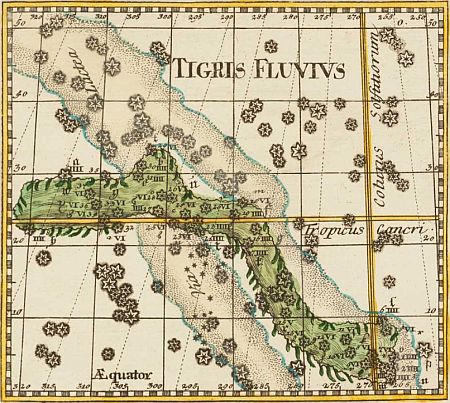Wikipedia
Ian Ridpath:
Star Tales
Lost
Constellations
|
Wikipedia |
Ian Ridpath: Star Tales |
Lost Constellations |


|
|
Star LoreTigrisThe River Tigris |
|


|
Tigris is a now obsolete constellation in the northern hemisphere, created in 1612 by Petrus Plancius.
|

Tigris, on some maps called Tigris Fluvius was a unique
constellation designed by Dutch-Flemish astronomer and cartographer Petrus Plancius.
 In its middle part, it was the only European equivalent to the Milky Way dark patch constellations of the South American Inca and of the Australian Aboriginal.  Ptolemy's descriptions of the constellations covered only the brightest stars, leaving a larger number of stars between the constellations unused or "unformed." Plancius connected a number of unformed stars to represent the River Tigris. The river.started at the neck of Pegasus, then flowed through a void between Cygnus and Lyra on one side and Aquila and Sagitta on the other side, and ended at the right shoulder of Ophiuchus.  In its central part, the path of the river led through a celestial valley: The Great Rift of the Milky Way are a series of dark nebulae that obscure the view at parts of the Milky Way from Earth's perspective.  This chain of dark spots has its beginning at the constellation Cygnus. This part is also known as the Cygnus Rift or as the Northern Coalsack.  It is this part from the Cygnus Rift to the dark patches in Aquila and Ophiuchus, where the constellation Tigris is not defined by certain stars, but instead, as John C. Barentine puts it, follows "... a path suggested by the relative absence of stars."  Many cultures on the southern hemisphere have whole sets of "dark" constellations. For the northern hemisphere, the dark part of the constellation Tigris is unique.  Tigris was first shown in 1613 on a celestial globe published by Pieter van den Keere and then in 1621 on a globe by Isaac Habrecht II. The river made its first appearance in a map in 1624 in Usus Astronomicus Planisphaerii Stellati (Astronomical Use of the Stellar Planisphere), a book and map by German astronomer Jakob Bartsch. It was also displayed in Andreas Cellarius' famous Harmonia Macrocosmica. |
 Mosul, on the bank of the Tigris, Eugène Flandin, 1861
Mosul, on the bank of the Tigris, Eugène Flandin, 1861Source: Wikipedia
|

 Mirrored image of Tigris and Euphrates in Harmonia Macrocosmica, 1660
Mirrored image of Tigris and Euphrates in Harmonia Macrocosmica, 1660Source: Wikimedia |
 Great Rift part on a map by Corbinian Thomas, 1730
Great Rift part on a map by Corbinian Thomas, 1730Source: alteagallery.com |

Cellarius added the river Euphrates Fluvius, originating in Cygnus and merging with Tigris in
the great rift.
 Unfortunately, the constellation was never very popular. In the late 1600s, Polish astronomer Johannes Hevelius placed his constellation Vulpecula and Anser in the space between Cygnus and Sagitta. When Hevelius' constellation was shown in Johann Elert Bode's trendsetting star map Uranographia, the fate of one of the - in my opinion - most creative constellations in the northern hemisphere was sealed.  Sources: Wikipedia, Ian Ridpath: Star Tales, John C. Barentine: The Lost Constellations |

 Tigris River;
Wikipedia
Tigris River;
Wikipedia
|


|
Back to Star Lore |

Back to Obsolete |

Back to Plancius' |
Back to Space Page |
Back to English |
 Back to Start Page |